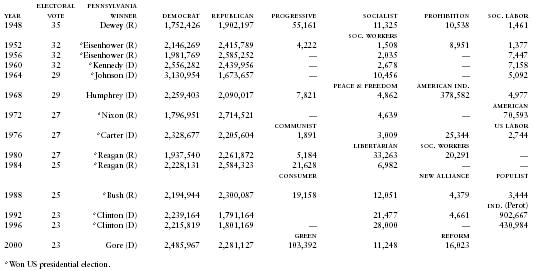Pennsylvania
Local government
As of 2002, Pennsylvania had 66 counties, 1,018 municipal governments, 1,546 townships, 516 public school districts, and 1,885 authorities (special districts). Under home-rule laws, municipalities may choose to draft and amend their own charter.
Pennsylvania counties are responsible for state law enforcement, judicial administration, and the conduct of state elections: counties also are involved in public health, regional planning, and solid waste disposal. Counties can also maintain hospitals, homes for the aged, community colleges, libraries, and other community facilities. The chief governing body in each county is a three-member board of commissioners, each elected to a four-year term. Other elected officials generally include the sheriff, district attorney, notary, clerk of courts, register of wills, recorder of deeds, jury commissioners, auditor or controller, and treasurer. Among the appointed officials is a public defender. Counties are divided by law into nine classes, depending on population. Philadelphia's county offices were merged with the city government in 1952, pursuant to the home-rule charter of 1951.
There are four classes of cities. The only first-class city, Philadelphia, is governed by a mayor and city council. Other elected officials are the controller, district attorney, sheriff, register of wills, and three city commissioners. Major appointed officials include managing director, director of finance, city representative, and city solicitor. Both Pittsburgh and Scranton

Pennsylvania Presidential Vote by Political Parties, 1948–2000
| YEAR | ELECTORAL VOTE | PENNSYLVANIA WINNER | DEMOCRAT | REPUBLICAN | PROGRESSIVE | SOCIALIST | PROHIBITION | SOC. LABOR |
| *Won US presidential election. | ||||||||
| 1948 | 35 | Dewey (R) | 1,752,426 | 1,902,197 | 55,161 | 11,325 | 10,538 | 1,461 |
| SOC. WORKERS | ||||||||
| 1952 | 32 | *Eisenhower (R) | 2,146,269 | 2,415,789 | 4,222 | 1,508 | 8,951 | 1,377 |
| 1956 | 32 | *Eisenhower (R) | 1,981,769 | 2,585,252 | — | 2,035 | — | 7,447 |
| 1960 | 32 | *Kennedy (D) | 2,556,282 | 2,439,956 | — | 2,678 | — | 7,158 |
| 1964 | 29 | *Johnson (D) | 3,130,954 | 1,673,657 | — | 10,456 | — | 5,092 |
| PEACE & FREEDOM | AMERICAN IND. | |||||||
| 1968 | 29 | Humphrey (D) | 2,259,403 | 2,090,017 | 7,821 | 4,862 | 378,582 | 4,977 |
| AMERICAN | ||||||||
| 1972 | 27 | *Nixon (R) | 1,796,951 | 2,714,521 | — | 4,639 | — | 70,593 |
| COMMUNIST | US LABOR | |||||||
| 1976 | 27 | *Carter (D) | 2,328,677 | 2,205,604 | 1,891 | 3,009 | 25,344 | 2,744 |
| LIBERTARIAN | SOC. WORKERS | |||||||
| 1980 | 27 | *Reagan (R) | 1,937,540 | 2,261,872 | 5,184 | 33,263 | 20,291 | — |
| 1984 | 25 | *Reagan (R) | 2,228,131 | 2,584,323 | 21,628 | 6,982 | — | — |
| CONSUMER | NEW ALLIANCE | POPULIST | ||||||
| 1988 | 25 | *Bush (R) | 2,194,944 | 2,300,087 | 19,158 | 12,051 | 4,379 | 3,444 |
| IND. (Perot) | ||||||||
| 1992 | 23 *Clinton | (D) | 2,239,164 | 1,791,164 | 21,477 | 4,661 | 902,667 | |
| 1996 | 23 | *Clinton (D) | 2,215,819 | 1,801,169 | — | 28,000 | — | 430,984 |
| GREEN | REFORM | |||||||
| 2000 | 23 | Gore (D) | 2,485,967 | 2,281,127 | 103,392 | 11,248 | 16,023 | |
(classified as second-class cities) are governed under mayor-council systems that give the mayors strong discretionary powers.
Boroughs are governed under mayor-council systems giving the council strong powers. Other elected officials are the tax assessor, tax collector, and auditor or controller. The state's first-class townships, located mostly in metropolitan areas, are governed by elected commissioners who serve four-year overlapping terms. Second-class townships, most of them located in rural areas, have three supervisors who are elected at large to six-year terms.